By Gary E. Reisenwitz, Photos by Dan Shea
Looking back at the history and evolution of small arms, it is sometimes amusing to see that man has continued to concoct ever more complicated machinery to propel a chunk of lead at his adversaries. Firearms have been with us for hundreds of years. The modern versions do little more than hurl the lead further, straighter, and at a higher repetitive rate. During the time in which we progressed from the railroad to space travel, we have been clever enough to hook an electric motor up to the back end of a Gatling gun. (which, incidentally, was first done nearly 100 years ago.) No one would sanely argue that the improvements in weaponry have not made the individual soldier more capable. An army equipped with matchlocks would not fare well against an equal sized army equipped with squad automatic weapons. However, the basic damage mechanism remains surprisingly unaltered. The individual infantryman carries a rifle that shoots a bullet.
The current M16A2 type rifles are virtually identical to the M16 rifles issued over thirty years ago. (Anyone prefer using a thirty-year old typewriter?) The “Black Rifle” has now been the standard service rifle within our armed forces for longer than any previous service rifle in the history of the United States and there does not seem to be any impetus to radically change. This lack of impetus is driven primarily by the current military and political philosophy which holds that the efforts of an individual infantry soldier do not significantly affect the outcome of a conflict. The military leadership and politicians of this country see the value and effect of precision guided munitions, heavy armored vehicles and aircraft as the determining factors to success on the modern battlefield.
This concept of reliance on the heavy hitters will probably serve us well, so long as we engage our enemy in a conventional battle, on their soil, and can afford the luxury of never having to physically occupy enemy territory. It is literally a philosophy of war by long distance. As long as this country’s strategic doctrine devalues the concept of occupation, there is little reason to improve small arms.
Changes in doctrine may occur. We have seen a growth in limited conflicts, such as in Grenada, Panama, Somalia, Haiti and Bosnia, to name a few. We have yet to see an elevation of the importance of the military success of these limited conflicts. Some feel the level of actual military success in these “small wars” has steadily declined. One would hope that the attitude of our military leadership changes before international events require it.
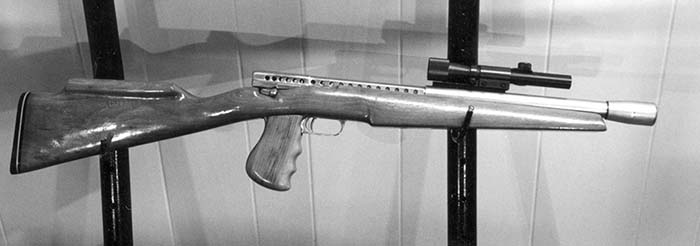
If and when the R&D begins in earnest for a replacement for the M16A2 series of weapons, the state of the art will determine the direction the replacement will take. There is a lot of new hardware out there, and directed energy weapons lie just beyond the technological horizon. Electrical and mechanical engineers lie in wait for the high- density, electrical storage devices and the high-temperature, super-conductive materials that once available, will permit the assembly of the hand-held, death-ray. (Current studies of charged particle beams, matter waves, high energy lasers, electro-magnet “rail guns” and others, show weaponization would be feasible if the thermal effects could be reduced by the use of electrically super conductive materials. “Super batteries” would enable portability.)
The homework has already been done. There are only these two parts missing from a most formidable puzzle that will change forever the very concept of war. When a single soldier has the lethality and range of a main battle tank; the tactics of the past will be of little value. A child, on the balcony of an apartment, will be able to engage and destroy a cruise missile several miles away. The intelligence gathering capability of our satellites, U-2 aircraft and others, will be vulnerable to even the smallest of air defense weapons available to the individual soldier. Air war itself may be rendered obsolete.
For those who are foolish enough to believe that man has evolved beyond the use of such extreme violence to effect political or social change, one can read any ancient text of their choosing and find an example of the evolution of the way humans think. We are no less prone to violent thought than we have ever been. We are simply more clever and judicious in its application. We have not “evolved” beyond violent war. I doubt we ever will.
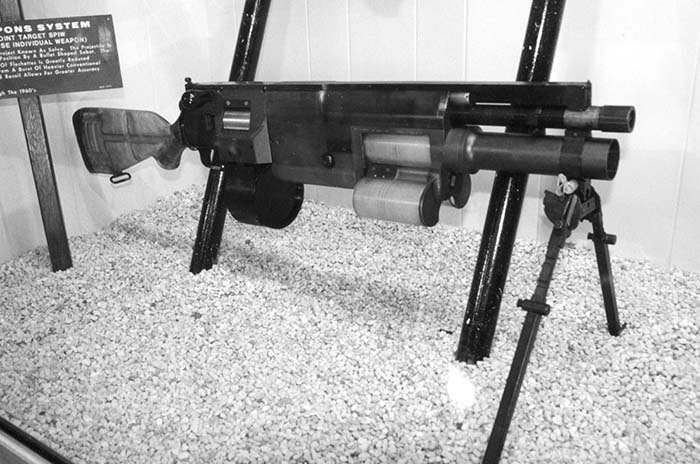
Making the bold assumption that some small arms improvements will occur before the advent of directed-energy weapons, there is a technically feasible weapon design that should be producable in the near term. This weapon may be developed because it would greatly improve the warfighting capability of the individual infantry soldier. The design may be a composite of several previous designs that were not commercially successful, but were mechanically sound. The key difference between this new weapon and every other small arm produced today is the reliance upon the enhanced capability of the cartridge, rather than the gun.
If real advances are to be made in small arms design, these advances must make the individual soldier more effective at his primary task, which is to kill, wound or destroy the enemy soldiers, material or equipment. Merely changing the cyclic rate of the weapon, changing the way it is taken apart to be cleaned, changing the diameter of the bore or the shape of the projectile, is not going to create enough of an improvement in the performance of the individual soldier to be worth the expense. A radical change in design will be required to produce a radical change in soldier capability. The change that some believe will succeed, will be to a “smart” munition.
The future small arm may be a semi-automatic rocket gun, firing rockets having smart-fuzed, high explosive, dual-purpose warheads. (I’m sure that at this point, many of you are now convinced that you are witnessing the ranting of a lunatic, but if you’ll bear with me, it may appear more feasible than you first thought.) These rockets could be approximately four inches in length and from 20-25mm in diameter. (The Gyro-Jet rocket “rifles” and pistols used 13mm self-contained rocket rounds and were produced in small commercial quantities over 30 years ago.) The “dual purpose” terminology refers to the ability of a single warhead to possess both armor penetration as well as anti-personnel capabilities. It could be designed to incorporate a shaped charge liner in the nose, with a pre-fragmented body surrounding the side and rear of a high explosive filler. (This is the standard warhead configuration of the US M430 HEDP (High Explosive Dual-Purpose) 40mm Grenade Machine Gun projectile, first fielded over 10 years ago.) This permits light armor, or barricade penetration upon impact, with anti-personnel shrapnel being discharged upon sensor directed warhead detonation.
The smart fusing would permit the following functions:
Set-back, or initial arming
Time delay arming for a minimum distance safe detonation
Inertial impact detonation
Maximum range detonation
Thermal signature “fly-by” detonation
The setback or inertial arming would insure that the ammunition would be reasonably safe in transit and storage. (Set back arming is common among modern fuze designs.) The time delay arming would insure that the warhead would not arm until it had traveled far enough away from the soldier to keep him safe from the shrapnel of his own projectile. (Most mechanical fuzes use spin arming to create the time delay.) The inertial impact detonation would permit the warhead to detonate upon hitting any target of sufficient density to warrant the need for shaped charge penetration. The maximum range detonation would insure that missed shots would not travel outside the combat area and present an unnecessary hazard to non-combatants, and would not leave “duds” for future generations to worry about. Maximum range would probably be on the order of 1000 meters. The thermal signature “fly-by” detonation mode would be the single feature that would make this weapon more effective than any other ever produced.
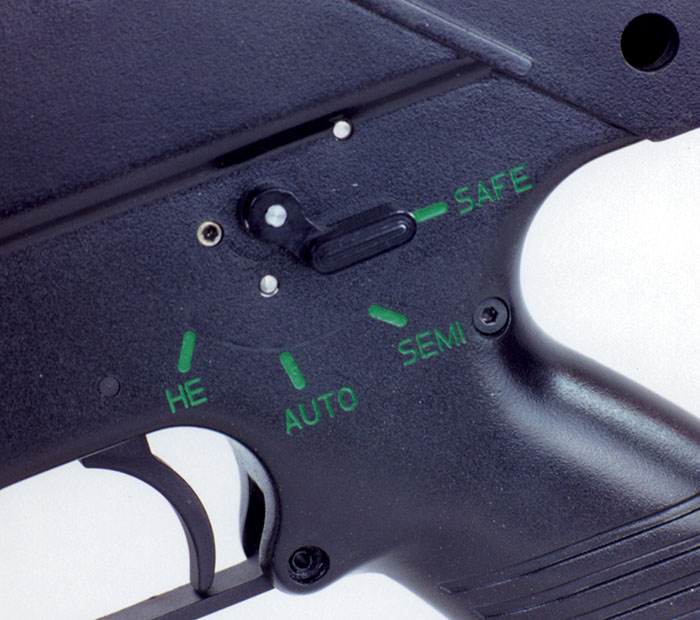
The “fly-by” fuze would free the soldier from having to accurately aim the weapon at his adversary. It would prevent the enemy from taking any advantage of cover or concealment. It’s concept is very simple. It is human nature to seek the protection of some physical object when participating in a violent exchange. Suppose the adversary has taken cover behind a stone wall and is only occasionally exposed. Engaging such an adversary with conventional small arms exposes the advancing party to extreme risk.
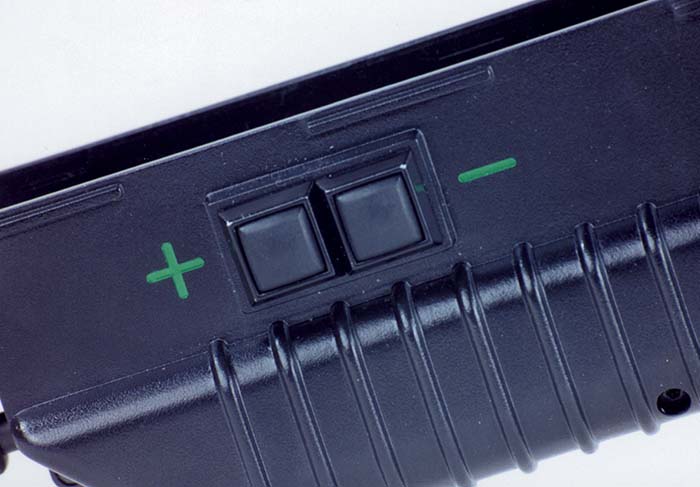
With a “fly-by” fuze and a dual-purpose warhead, the soldier need only fire a single shot above the stone wall. When the rocket passed over the wall, the thermal sensing fuze would detect the temperature differential between the thermal signature of the enemy soldier’s body, and the more neutral surrounding, and detonate in the air, immediately past the soldier. The pre-fragmented warhead body would throw a shrapnel pattern, backward, into any of the enemy soldiers hiding behind the wall. By striking them from the rear, they would receive the minimum protection from any protective clothing they might have and would be severely injured, if not killed. With a casualty radius of three meters; accuracy and precision could be safely traded for speed of engagement and a reduction in volume of fire. If a shot were fired at an enemy soldier running in the open, the projectile would not have to strike him to take him out. It would simply have to pass within 3 meters of him to cause warhead detonation behind him, and subsequent casualty. Enemy soldiers lying prone would be equally vulnerable. Soldiers seeking cover in lightly armored vehicles could be attacked by direct fire, with the shaped charge allowing penetration of light armor, and liquid metal spalling adding to the effect. A sniper firing through a window could be engaged by putting a shot through the window (fly-by fuzing) or through the wall (shaped charge fusing). Enemy soldiers unlucky enough to be hit at ranges too close to permit primary fuze arming (probably 20 meters) would get a 20-25mm hole in them. If the projectile lodged in them, the maximum range fuze would detonate the warhead within a few milliseconds. It would be difficult to argue that a degradation in lethality would occur if such a weapon were used to replace standard small arms and conventional ammunition.
The key to the success of this type of warhead is in the electronic fuze. Skeptics may argue that there is no way to get that kind of function in something as small as the nose cone of a 20-25mm projectile. This can be countered with the fact that we now have the ability to manufacture at the atomic level (although currently, only in a laboratory environment), and the industrial field of micro-miniaturization is one of the fastest growing, with no end in sight. (The Pentagon is seriously investigating the use of sensors, for surveillance, that are small and light enough to be carried in the wind as “dust”. [ Army Times, June 9, 1997, page 34] )
So what would the “rocket gun” look like? A bull-pup version of the old Gyro-Jet would be a reasonable guess. It might use a rotary three-chambered cylinder, a-la Dardick Tround, so no fore-aft reciprocating parts would be required. It might use disposable-preloaded plastic magazines (of 10 round capacity; we certainly wouldn’t want to create an “assault rifle” now would we.). The magazines might also use their springs to power the revolving cylinder, further simplifying the base gun. The bore could be internally fluted (like ultra-deep rifling) to guide and support the rocket during the motor burn, but permit the exhaust gasses to vent forward, but diffused, to lower the recoil. The rockets could be held within the plastic trounds during firing, and the motors could be designed to insure complete combustion within the bore. This would insure high velocity, while making it more difficult to trace the trajectory of the projectile back to the soldier. (Tracers work both ways.) The gun might work like the Striker shotgun, where the revolving “tround” cylinder would advance when the trigger was released, but would have a crisp “pull” for more practical accuracy (not precision). The entire weapon could be made from plastics and light metals because no great stresses would be placed upon it during firing. It could be made very light, simple and cheap. Because the weapon would be designed for rapid target acquisition and engagement, the sight system would have to be a both-eyes-open heads up display type. Snap shooting or instinctive shooting would be the norm, with little time spent on precision target engagement, unless the tactical situation required it. Accuracy would not necessarily be degraded to unacceptable levels, but this would not be a match rifle. Simple aerodynamics and inertia would most likely achieve projectile stabilization.
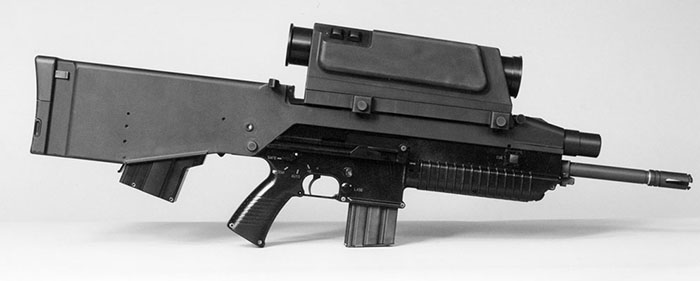
Since the motor would be designed to burn out within the launch tube; the rocket and warhead would emerge from the end of the “muzzle” at maximum velocity and continue in flight only by inertia. The use of a lightweight motor body would enable the expended rocket motor casing to be much lighter than the warhead tip of the cartridge. The simple principle of placing the center of gravity (due to the relatively heavier warhead) in front of the “center of pressure” (designed into the cartridge by fluting the exterior or casting in small fins), would enable the cartridge to have reasonable stability in flight over the ranges it would be expected to travel (under 1000 meters). Of course, experimentation might reveal even more simplistic or effective ways to achieve in-flight stabilization. The Gyro-Jet used angled rocket nozzle ports to impart rotation to the rocket, but had to give up linear thrust (range) in exchange for gyroscopic stability. The cartridges would be fairly expensive, but not nearly so many would be required. The Vietnam experience indicated that conventional rifles and machine guns expended tens of thousands of rounds per enemy soldier killed. Even if the cost per cartridge were 1000 times that of a conventional cartridge, it might still prove cost effective. (It might be cost effective at 10,000 times the cost of conventional ammunition.) The uniqueness of the cartridges would make replicating or capturing the launchers/weapons of no value to an adversary. The “gun control freaks” would love it because even if the weapons were stolen, they would be absolutely useless without the specially designed ammunition they would use. The simple nature of the weapon and the lack of a requirement for precision target engagement would reduce training time. Practice firing could be conducted with training ammunition that lacked the expensive electronic fuzing and high explosive warhead, but utilized electronically sensitive targets that offered immediate visual feedback, simulating warhead detonation. So this may be the next real evolution in military small arms design. Some real advancement in the design of the individual soldier’s primary armament is long overdue. If the military need arises and the two missing components to the directed energy weapons are not yet mature, this is the logical step to take. Unfortunately, the decisions about such things are made by politicians more often than tacticians.
Since none of our current crop of national leaders has had any foxhole experience, there is little basis for optimism.
| This article first appeared in Small Arms Review V1N3 (December 1997) |










